Top 5 Rare Garden Birds
There are a whole host of birds that are regular garden visitors and we’re going to look at my Top 5 Rare Garden Birds in this second instalment of my Guest Mini Series with Welsh Slate Water Features. In part one I talked about the most common faces, click here to read my Top 5 Birds To Spot In Your Garden guide. A few other common birds, no less important, would be the Blackbird with it’s beautiful multi-toned song. The Wood Pigeon, being one of the largest birds likely to visit your garden is an easy spot and the Starling in its large family groups and their loud chittering is a welcome sight. Now that we’ve covered some of the more common birds you might expect to see in your garden, let’s cast our gaze at some of the more rare birds that might drop in to see you. Some of these are more common than you might think, although the can take a little bit more a conscious eye to see. So let’s get into them a little bit, shall we?
1. Greenfinch
Chloris Chloris
A fleeting splash of green and yellow.
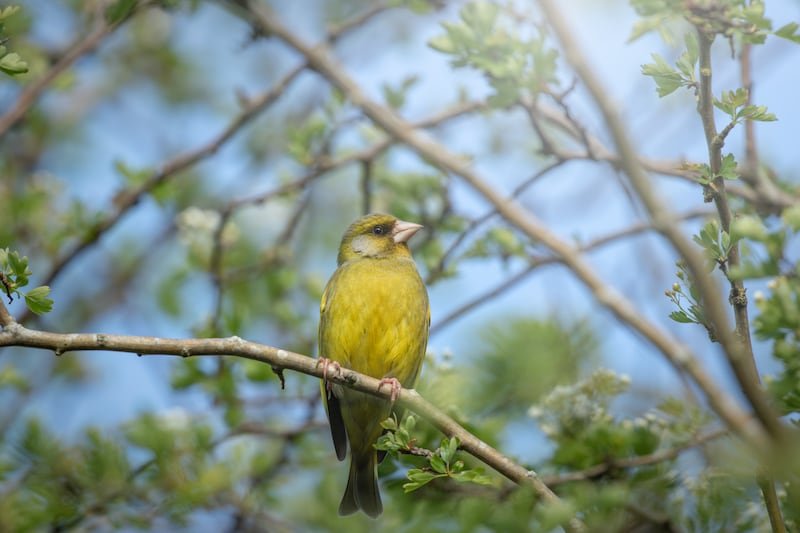
One of the larger members of the Finch family, by appearance, at least. When talking about the size of songbirds, and their larger family, we’re talking about grams. But, in appearance, the Greenfinch stands somewhat taller than most of it’s kin.
This beautiful bird was, at one time, plentiful across the British landscape. In recent years they have been on a steady decline largely believed to be due to a parasite-induced disease called Trichomonosis which prevents them from feeding properly. At the time of writing this article they have been seeing an increase in numbers. Normally being found in more rural areas the Greenfinch is starting to make a come back to more built up places, but their numbers are not what one would call plentiful.
They are, as the name would suggest, green. Or at least mostly green. They have a yellow fleck along the wing with a little bit of grey across the bottom of the wing and tail. Being 15cm from top to tail and up to 28g makes them somewhat larger than their Goldfinch relatives. Normally seen on the borders and hedges of fields and woodland but as previously mentioned more regularly making their way to smaller gardens and parks.
Top Tip: Their call is a singular, quite long, high pitched call that lowers in tone towards the end. It’s quite distinct and unlike almost any other bird call.
2. Dunnock
Prunella Modularis.
Master of camouflage in the canopy.
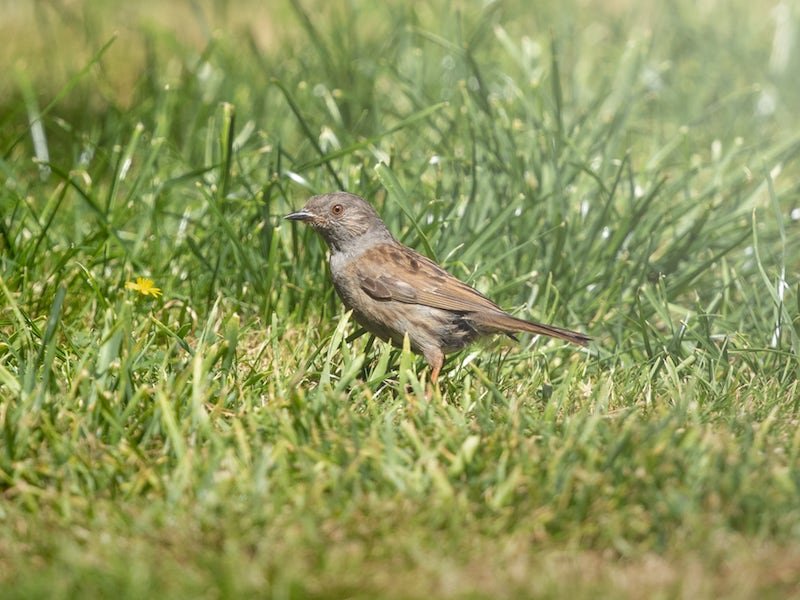
This incredible little song bird isn’t easy to spot when it’s hiding in the branches and hedges. Fortunately, they’re commonly found feeding on the ground. Normally a very quiet and lesser seen bird, when they’re feeding you might see them hopping through the grass or on the pathways of your garden. Their diet consists mainly of spiders, insects, worms and seeds.
They’re an unobtrusive bird by nature but when two rival males are competing there will be a lot of wing-flicking and loud calling. As a rule you’ll see the Dunnock singly or sometimes in pairs, but rarely more than this. This may be the reason that they’re lesser seen, because they travel in smaller parties. They are the sole member of the Accentor family in the UK which gives them a fair exclusivity, again possibly a reason they are lesser seen. All that being said, if you know what to look for there’s a reasonable chance you might see them.
They are somewhat closer to the size of a Sparrow, up to 21cm from beak tail. Weighing in at around 21g. Very much average in terms of their size, but their colouration is quite unique. They have a light brown back and wing feathers with a light grey chest, belly and neck. Their cheeks, back of neck and top of their heads are a darker grey. With a complex song they make their presence known. A rolling multi-toned song which is quite similar to that of the House Sparrow we talked about earlier. At first glance, they can be confused. But a more in focused look will reveal the difference in the colouration. And, once you’ve heard the birds you’ll easily distinguish the song one from the other.
Top Tip: Quite an exclusive little beauty to have grace your garden. Keep your eye open for that grey chest and belly, it’s a dead giveaway.
3. Great Spotted Woodpecker
Dendrocopos Major
Greater spotted but not often seen.
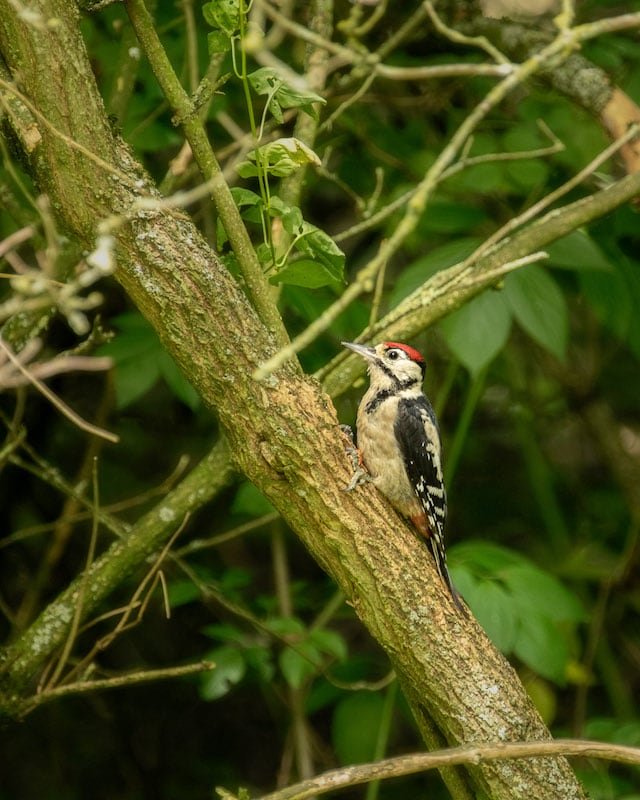
The Greater Spotted Woodpecker is a bird that’s fairly widespread, albeit not all that often seen. They inhabit majority of the woodlands across the UK and frequent gardens near to wooded areas, especially if you hang nuts in feeders. We’ll get onto this in more detail shortly. There are three species of Woodpecker in the UK, the Greater Spotted Woodpecker, Green Woodpecker and Lesser Spotted Woodpecker.
Now, to discuss comparative chances of viewing these species is probably unfair as they’re all quite rarely seen. The Green Woodpecker is quite easily distinguishable from the other species as it’s bright green with a red head. The Greater and Lesser Spotted Woodpeckers are reasonably similar in colouration but that’s where the similarities end. The Greater Spotted Woodpecker is considerably larger than the Lesser Spotted, this is the most notable difference. There is some colouration variation but it’s not too dramatic. The Greater Spotted has a more formed pattern with larger white spots on the wings than does the Lesser Spotted. The Lesser Spotted has a more evenly spread pattern between black and white across the wing.
But we’re here to talk about the Greater Spotted Woodpecker as something that has a reasonably better chance of being seen. With that in mind, this particular bird is most active at first light or last. To be in with a chance of seeing these incredible birds your best bet is to be up early looking among the trees. But if you have feeders in your garden carrying nuts there’s a strong chance of one of these incredible woodland birds visiting you. They have a very varied diet of insects, seeds and nuts, but they are also known to be predatory feeding on the chicks of other bird species. They will always choose an easy food source over a difficult one, however. If you have nuts in feeders in your garden you stand a fair chance of seeing a Greater Spotted Woodpecker visiting you.
So, how can you identify one?
They have a white chest and belly, with red finishing the under-tail. Mostly black on the back and wings, with long elliptical white patches on the wing. With a black beak, white face and cheeks with a black head and a flash of red on the back of the neck. Quite a varied description for what we imagine to be a Woodpecker. It’s rare to hear a Greater Spotted Woodpecker call, but if you do it’s a loud “pick-pick” sound. But most likely you’ll hear them hammering at a tree, possibly the most well-known sound of a Woodpecker.
Top Tip: plenty of tapping in the trees and they absolutely love nuts in feeders. They’ll be easy to spot purely because of their size!
4. Sparrowhawk
Accipiter Nisus
The winged hunter of the garden.
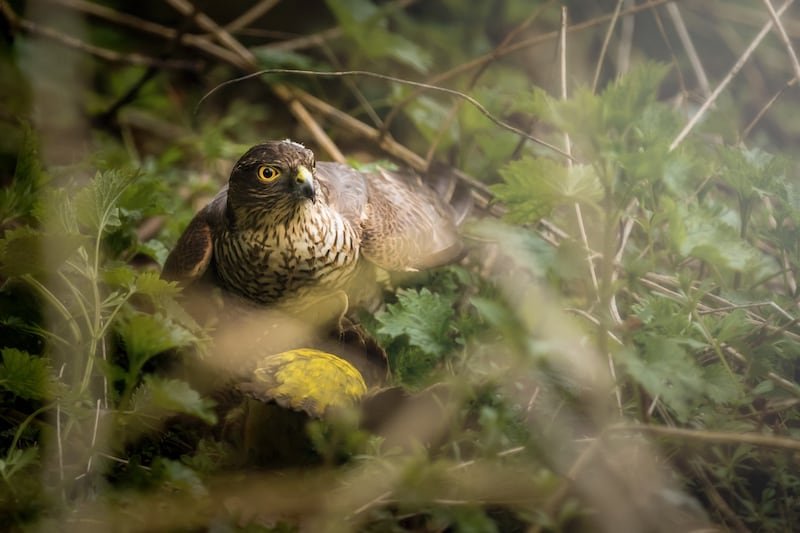
Ok, so we’re getting into more serious birds now. The Sparrowhawk, as the name suggests, is part of the Hawk, Kites and Eagles family. They are a small bird of prey, and as a bird of prey they are on the lookout for other creatures to eat. Sparrowhawks mostly eat other birds and will catch them in flight at times, or by swooping in to take them from the ground or limbs of trees. They have also been known to catch bats, which is testament to their aerial ability.
The males are slightly smaller than the females and will comfortably tackle birds up to the size of a Thrush. The females being slightly larger have been known to take on pigeons. Songbirds, as a rule, will make up a large part of the Sparrowhawk’s diet. If you have feeders or stations in your garden for songbirds, there’s a reasonable chance you’ll get the occasional visit from a Sparrowhawk. Being a bird that normally inhabits woodland you might think it’s rare that you’ll see one if you don’t live near, but rest assured these birds go where the food is. If you have regularly visiting songbirds there stands a fair chance you’ll see Sparrowhawk at some point.
They very easily identifiable from almost any other bird that’s likely to visit your garden. Being somewhere around Pigeon sized they’re not what you’d call particularly small. In the world of birds of prey they are considered to be one of the smaller species. Let’s talk about the male first. Up to 30cm from top to tail, weighing up to almost 200g. Blue-grey on the back, wings and head. White upper chest and buff, almost tan coloured belly. Yellow legs and feet, with a yellow beak tipped with black. The females are considerably larger than the males at around 38cm from head to tail and up to 350g. Their plumage is slightly different too, carrying brown across the back and wings with layers of brown and white across the chest and belly. The legs are the same with the yellow colouration. The beak too, yellow with black tip.
Top Tip: The key to spotting this awesome hunter is keeping an eye on any feeders you might have. If they’re busy with smaller birds there’s always a possibility of a Sparrowhawk dropping in for a meal.
5. Common Kestrel
Falco Tinnunculus
Beware the hover.
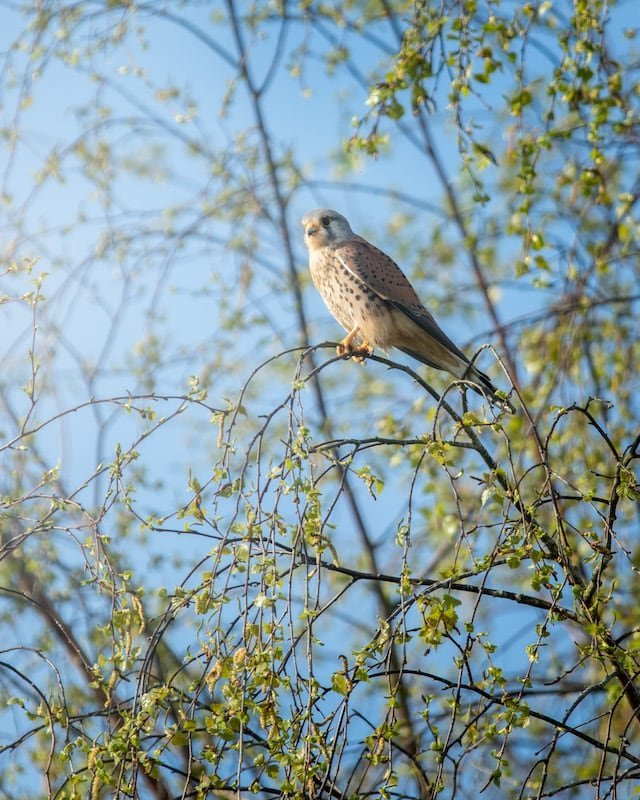
The Kestrel is a fairly common bird in rural areas with them normally being seen hovering over fields where they’ll hunt. Despite carrying an Amber alert on the UK Conservation Status you might see them in your garden if you’re near rural areas or have a garden visited by birds and small mammals such as mice or voles.
The most identifying behaviour of the Kestrel is it’s ability to hover. They’d beat the wings back and forth, fanning their tail feathers out for stability as they follow their prey below, all the while holding a static position in the air. They’re not the only bird to have this ability with similar members of the Falcon family having similar abilities. The Merlin and Hobby have been known to behave similarly. Other birds of prey also have the ability. The Kestrel is most likely the one you’ll see exhibiting this behaviour above it’s hunting ground. So, if you see a bird around the size of a Magpie hovering above your garden you can be fairly sure it’s a Kestrel.
They are fairly easily identifiable if you can get a good look at them. They have a tendency to soar and hover quite high so they can be difficult to identify individual markings sometimes. Their plumage is a reddish brown across the back and wing feathers. A blue-grey neck, head and face with a black vertical stripe running down from the eye. A cream-white chest and belly with brown speckles. Being similarly sized to the Woodpecker at up to 35cm in length, weighing around 250g makes them quite a small hunter.
Top Tip: Their call is a short repetition of high pitched chirps, but really quite loud! While technically being quite a scarce bird, given the right conditions it’s possible to see them hanging around your garden.
I hope this article has given you some useful insights into the Top 5 Rare Garden Birds and what you can plan to spot in your garden. Remember, it’s all about patience and persistence. If you give the wildlife in your garden your time, you’ll be rewarded with a great show.
Take care everyone,
Gareth.
Gareth Kelley Website
Gareth Kelley Facebook
Gareth Kelley Instagram
We’re privileged and proud to present Top 5 Rare Garden Birds, a truly unique guest post by exceptional UK wildlife photographer Gareth Kelley.
Please follow Gareth via social media, links at the bottom of the post.

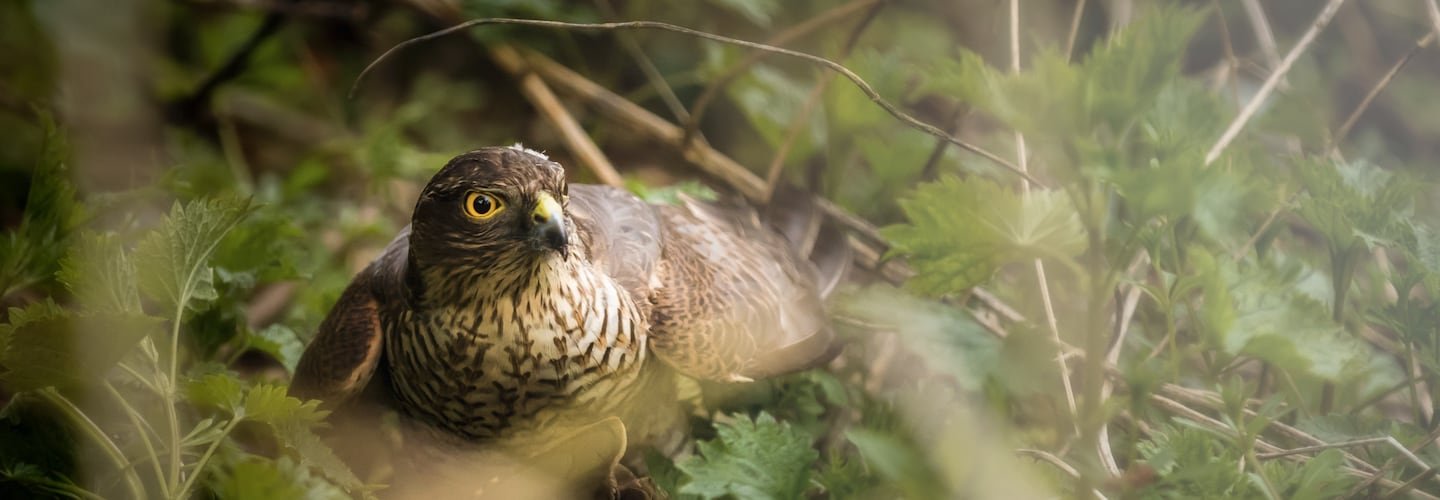
I have a family of woodpecker’s in my garden In London Neasden